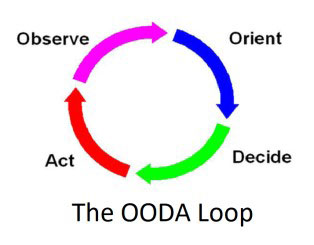Hands-on Self-Defense (Unarmed)
Severe Weather Preparedness

Look out for the dogs, look out for the evildoers ... (Philippians 3:2).
Be sober-minded; be watchful. Your adversary the devil prowls around like a roaring lion, seeking someone to devour (1 Peter 5:8).
But the man of God sent word to the king of Israel, “Beware that you do not pass this place, for the Syrians are going down there” (2 Kings 6:9).
Look Out! Watch! Beware!
On a TV show, the hit man returns to the Boss.
"Did you get them?"
"Sure. They never knew what hit them."
Unless you're rooting for the Mob, your reaction could be, "How sad! If they'd been more watchful they wouldn't have been killed."
We don't live on a TV show. We live in the real world, where being alert is a necessity, not just part of the script. Many times it is the difference between life and death. If you think about it, you could tell about times when being aware of traffic, pedestrians, and objects in the road let you avoid an accident.
Situational Awareness
An essential component of safety and security is situational awareness. This is both environmental awareness, being alert to what is around you, and being aware of the situation - what is happening and what is developing.
On the safety side, a safety team member walking down the hall might notice the fire extinguisher slightly out of place. This could just mean that someone accidentally bumped it, or it could mean that it's been tampered with. The member could spot a tear in the carpet - a tripping hazard. A water spot in the ceiling tiles could indicate a leak, possibly leading to a slipping hazard.
On the security side, the team member sees a door ajar which should be closed. Did a teacher or student forget to close the door? Or has someone gone in who shouldn't be there? If so, are they still there?
First Line of Defense
With any activity, we want to know, "What is first?" The phrase "First line of defense" has been used for generations for the point at which an enemy first encounters your defenses. In national defense, this "first line" is not soldiers, airmen, sailors and marines. It is not walls, forts, trenches and gun emplacements. It is intelligence. From surveillance, espionage, and piecing together known facts, we become aware of a potential or present enemy's intentions, capabilities, and actions.
In church safety and security ministries, we do not conduct espionage. We do, however, keep tabs on developing situations in the congregation and the community to discover and assess potential threats. In other words, the ministry as a whole is practicing situational awareness.
Situational awareness is likewise a key ingredient of personal defense. As Kat Ainsworth of Range 365 says, it is "The First Line of Self Defense" (1). This means that we are less likely to be surprised by an attacker, then are ready to defend ourselves with what we have.
Watchfulness
When Peter wrote, "Be sober-minded; be watchful," he was speaking of our number one adversary, Satan, the Devil. Paul hits closer to home with "look out for the evildoers." People who would harm us, intentionally and unintentionally, do not usually wear tags that say, "I'll hurt you." Unless we've been warned about a specific threat, we have to judge by appearances, and actions.
Look, Listen
Most of us have seen the signs at unguarded railroad crossings. Beneath the rail crossing X is the notice: "Stop, Look, Listen." In situational awareness, we don't always have to stop, but we do look and listen.
I remember when I was a young man, I turned quickly and took a step back at the same time, knocking books out of someone's hand.
"Sorry!" I said, "I don't have eyes in back of my head."
"I know," was the reply, "That's why God gave you a neck."
Use your peripheral vision. Avoid focusing only on one thing, such as a cell phone or a closed circuit TV monitor. Use what Ainsworth calls, "Soft Eyes." Practice seeing as much as possible in each glance.
For situational awareness, looking is not just seeing if somebody is there. Practice environmental awareness. Where can an assailant hide? Where can I get out? What can an assailant use as a weapon?
Notice the people. Does anyone look disturbed? Acting up? Angry? Does anyone act suspiciously? If a person comes in with a plan to attack, they can pretend to be normal, such as the young man who killed nine people at Emanuel AME Church. Would we detect the deceit? Does someone appear to be hiding something?
Not all attacks are pre-planned. Someone can become angry and strike at you or another person. Would you see this in time to take evasive action and defend yourself or whoever is the target?
In the Loop
The more we know about people we may encounter and existing situations, the more likely we are to recognize a developing threat. We may actually be warned about a threat, as the prophet warned the King of Israel in 2 Kings 6:9. If so, it is up to us to act responsibly and be ready for self-defense.
The OODA Loop

Col. John Boyd, a U.S. Air Force fighter pilot, veteran of three wars, was known as "Forty second Boyd" because he could win an aerial dogfight in 40 seconds or less (2). Based on his own experiences and observations, he developed and taught a means of processing and using changing information quickly and efficiently. It is called the OODA Loop (3). It is a continuing cycle of four steps: Observe, Orient, Decide, Act. From aerial combat, OODA is now applied in many areas of life, such as marketing, sports, law enforcement, and security. It is also taught as part of personal defense.
The Mental Component
The OODA Loop is the mental component of situational awareness. Writing for the Pennsylvania Psychological Association, Donald McAleer says,
Safety is something that happens between your ears, not something you hold in your hands.
- The mind is the weapon, all else is supplemental
- Awareness makes up 90 % of self defense, the remaining 10% is physical technique (4)
OODA Loop in Action
Paul wrote, "Therefore let anyone who thinks that he stands take heed lest he fall" (1 Corinthians 10:12). He also said, "Look carefully then how you walk, not as unwise but as wise" (Ephesians 5:15). [Italics are mine.] We know that the apostle was talking about how we live, but the principle can be applied to security and preventative self defense.
Being aware of what and who are around us, we analyze the data, then determine and execute a plan of action. The intent of OODA is to continuously adapt to continually changing situations. All four steps of the OODA Loop are in play at the same time. While deciding what to do, we are still observing our dynamic environment and recognizing our dynamic orientation. This means that we can instantly react to change.
Reaction Times and Distances
Self-defense, especially unarmed defense, has to take reaction times and distances into consideration. What this means is that when a threat is perceived, we maintain enough distance so that we have time to react. More than distance, this is also how we stand or how we approach them.
Reaction distance is the distance an average person could begin an attack and reach you before you can effectively react. This varies by if and how the assailant is armed. The generally accepted rule is 6 feet for an unarmed person, 21 feet for someone armed with an edged weapon, and line-of-sight without cover if they have a firearm. Using situational awareness, we try to discern whether or not a potential attacker is armed, and if armed, with what.
Cooper's Color Code of Awareness
What is your level of awareness? Will you be able to spot a developing threat in time to effectively defend yourself and others? Jeffrey Cooper, a U.S. Marine war veteran, devised a color code of mental states, which has become generally applied to levels of awareness. Now known as the Color Code of Awareness (5), it has four levels, from blissfully unaware to ready to fight. Abbreviated, it is:
White: Unaware and unprepared.
Yellow: Relaxed alert. No specific threat situation. Your mindset is that "today could be the day I may have to defend myself."
Orange: Specific alert. Something is not quite right and has your attention. Your radar has picked up a specific alert.
Red: Condition Red is fight. Your mental trigger (established back in Condition Orange) has been tripped.(6)
Illustrating the Color Code of Awareness
Here is a story showing the difference between one person at the Yellow level and another at White:
Two persons leave Betty's Boutique and head down Market Street, first Meghan, then Lucy.
Meghan pockets her smart phone and keeps her head up while walking. She brushes her hair back with her hand, increasing her peripheral vision. Her eyes move side-to-side, and she turns her head frequently.
Jack Brown sees Meghan coming down the street and shrinks back into the shadows of an alley, remaining hidden until she has passed. Then he slips out of the alley onto the sidewalk behind her.
Walking past a store window, Meghan catches a glimpse of Jack behind her. Pulling her right hand into defensive readiness, she changes the grip on her purse with her left hand so it can be swung as a weapon as she moves her head first to the right, then to the left.
Jack sees Meghan's reaction and steps into a doorway. Half a minute later, he heads back to the alley.
When it is safe to do so, Meghan pulls out her phone and calls 911.
Now Lucy comes down the sidewalk, smart phone in hand. She is so engrossed with texting that she almost trips on a crack in the pavement. As she passes the alley, Jack slips in behind her. Lucy has a Black Belt in martial arts, but she'll never get a chance to use it.
Lights off, a police car comes around the corner in response to the suspicious person report. The officers see Lucy down and Jack running from the scene. One officer tends to Lucy while the other chases Jack.
Meghan began her walk at Level Yellow. Seeing Jack's reflection, she quickly passed to Level Orange, then Red. Jack turned back because he saw she was ready for him. Lucy remained in Level White until it was too late.
How Would Situational Awareness Benefit Me?
Simply put, we can use situational awareness to be ready. Being ready means:
- We can avoid trouble.
- We will be ready to defend ourselves.
- An intended troublemaker may see that we are ready and back off.
Resources
Sheepdog Church Security Online Training [https://sheepdog-church-security.thinkific.com/collections]
- "Church Safety and Security Volunteer Academy" [https://sheepdog-church-security.thinkific.com/courses/church-safety-and-security-volunteer-academy].
- "Protecting Yourself and the Church with Use of Force Laws" [https://sheepdog-church-security.thinkific.com/courses/protecting-yourself-and-the-church-with-use-of-force-laws].
References
- K. Ainsworth, "Situational Awareness 101: The First Line of Self Defense", Range 365, October 6, 2017 [https://www.range365.com/situational-awareness-101-first-step-self-defense].
- "John Boyd (military strategist)", Wikipedia [https://en.wikipedia.org/wiki/John_Boyd_(military_strategist)].
- "OODA Loop", Wikipedia [https://en.wikipedia.org/wiki/OODA_loop].
- D. McAleer, "Situational Awareness" (presentation for a lecture), Pennsylvania Psychological Association, May 22, 2017 [http://www.papsy.org/resource/collection/26D900A1-67D1-4065-BB46-BA1DC883044D/W30%20-%20Theme%20Lecture%20-%20Situational%20Awareness.pdf
- "Jeff Cooper", Wikipedia [https://en.wikipedia.org/wiki/Jeff_Cooper].
- Rosenberg, Joel (2011), The Carry Book: Minnesota Edition, Elegon, p. 52. ISBN 9781257015948.




